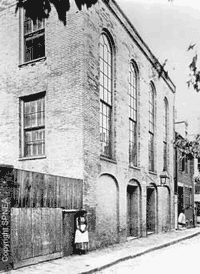|
| |
| |
American jazz icon Louis Armstrong was welcomed all over the world and
could live anywhere he wanted, but from 1943 until his death in 1971, a
two-story frame house in Corona was his home. A New York City and
National Historic Landmark, the Louis Armstrong House is scheduled to
open as a museum in the year 2000, enabling the public to step into
Armstrong's own "wonderful world." The Archives at Queens College
contain the artists' vast personal collection of photographs, papers,
scrapbooks, recordings, memorabilia and musical instruments. Armstrong
recorded 650 reel-to-reel tapes of conversations and performances which
require urgent attention to be saved from deterioration and loss. The
First Lady is joined by Wynton Marsalis in a salute to the great Satchmo
and to the value of preserving America's creative legacy.
Breed Street Shul The old and the new are united at the Breed St. Shul, an historic synagogue, where the Jewish Historical Society is working with the Boyle Heights Neighborhood Council and the East Los Angeles Community Corporation to "honor the past -- imagine the future." The partners hope to establish a museum honoring the Jewish heritage of the neighborhood and a community center with space for educational and cultural programming for current residents. The rehabilitation is in the early stages and has already garnered support from a wide array of community members including volunteers, nonprofit organizations and elected officials. Los Angeles, California Lavish vaudeville and movie houses along Broadway reveal the excitement and magic of an era in the cultural life of Los Angeles. Their historic architecture and interiors are depicted in movies, television shows and music videos. Innovative restoration and re-use plans with committed partners including property owners, nonprofit organizations, city agencies, and individual volunteers, are keeping alive the rich stories these theaters have to tell for another generation.
We stand at the convergence of a new century and the next millennium -- a milestone in human history. That is why the President and First Lady created the White House Millennium Council -- to set themes, engage the federal agencies and invite all Americans to participate in meaningful activities through the year 2000. The overall theme of the White House millennium activities is "Honor the past -- Imagine the future." The President and First Lady are inviting states, communities, non-profit organizations, federal agencies, and all citizens to participate in activities that strengthen our democracy, improve communities, and give lasting gifts to the future. The President has invited governors, mayors and other elected officials to involve citizens in marking the Millennium; many cities and towns are creating "Year 2000" committees to plan events. For more information about the Save America's Treasures Program and other Millennium Council initiatives, please contact:
The White House Millennium Council
Built in 1759 for Major John Vassall, a wealthy Tory who fled Cambridge
in 1774 on the eve of the Revolution, the house was used for a time as a
hospital for wounded American soldiers after the battles of Lexington,
Concord and Bunker Hill. Between July 1775 and April 1776, General
George Washington was headquartered in this grand home and here he
planned the Siege of Boston. In 1843, Nathan Appleton bought the house
as a wedding gift for his daughter, Fanny, and her new husband, and thus
for almost half a century (1837-1882), it was the family home of Henry
Wadsworth Longfellow, one of the world's foremost poets, scholars and
educators. The National Park Service has managed the site since 1972.
Currently closed for a major rehabilitation to install fire, security and
environmental control systems, the national historic site is planning
increased public educational programs. These include cataloguing and
preserving the archives, establishing a Center for Poetry and the
Imagination, and restoring the gardens and grounds.
 African Meeting House Boston, Massachusetts
This oldest standing African American church in the U.S. was built in
1805 and 1806 almost entirely by black labor with funds raised from the
entire community. The Meeting House became a center of religious and
cultural life. Abolitionist Frederick Douglass recruited the historic
54th Regiment of the Massachusetts Volunteer Infantry at the African
Meeting House and William Lloyd Garrison, a white integrationist,
launched the New England Anti-Slavery Society from this building on
January 6, 1832. Owned and operated by the Museum of Afro American
History, a nonprofit educational organization, the African Meeting
House is part of the Boston African American National Historic Site and
is managed in partnership with the National Park Service. The building
will undergo restoration in 1999, but the collections need additional
curatorial care so that they may be used in the museum's educational
programs.
Conservatory of Flowers Made of glass and redwood, the Conservatory's elaborate construction was modeled after London's Royal Conservatory of Kew Gardens. It is the oldest municipal wooden conservatory in the nation and houses many plants from the rain forests of Central and South America and the Pacific Islands, where destruction of native habitats endangers their survival, as well as plants whose origins date from prehistoric times. Both age and natural causes, such as numerous earthquakes and storms, are responsible for the deterioration of the Conservatory. A 1995 condition assessment found that the Conservatory has significant deficiencies which, with the absence of seismic strengthening, pose a life-safety risk in the event of future earthquakes or storms. It closed to the public in 1995. A generous challenge grant, along with support from the City, and contributions from the public, will provide for the restoration of this landmark building.
President and First Lady | Vice President and Mrs. Gore |